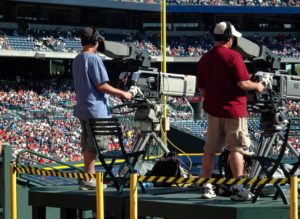By Kevin Praik
February 14, 2019
BANGOR, Maine – On the campus of Husson University, a new safety device is in place and it is a piece of cold weather technology. It is an ice warning sign. When the temperature drops below about 37 degrees Fahrenheit, a blue LED light starts flashing warning people on the campus of the hazard of ice on the ground.
The ice signs were purchased because of Husson Auxiliary Services records a lot of slips and falls during the winter months; Particularly in December – February.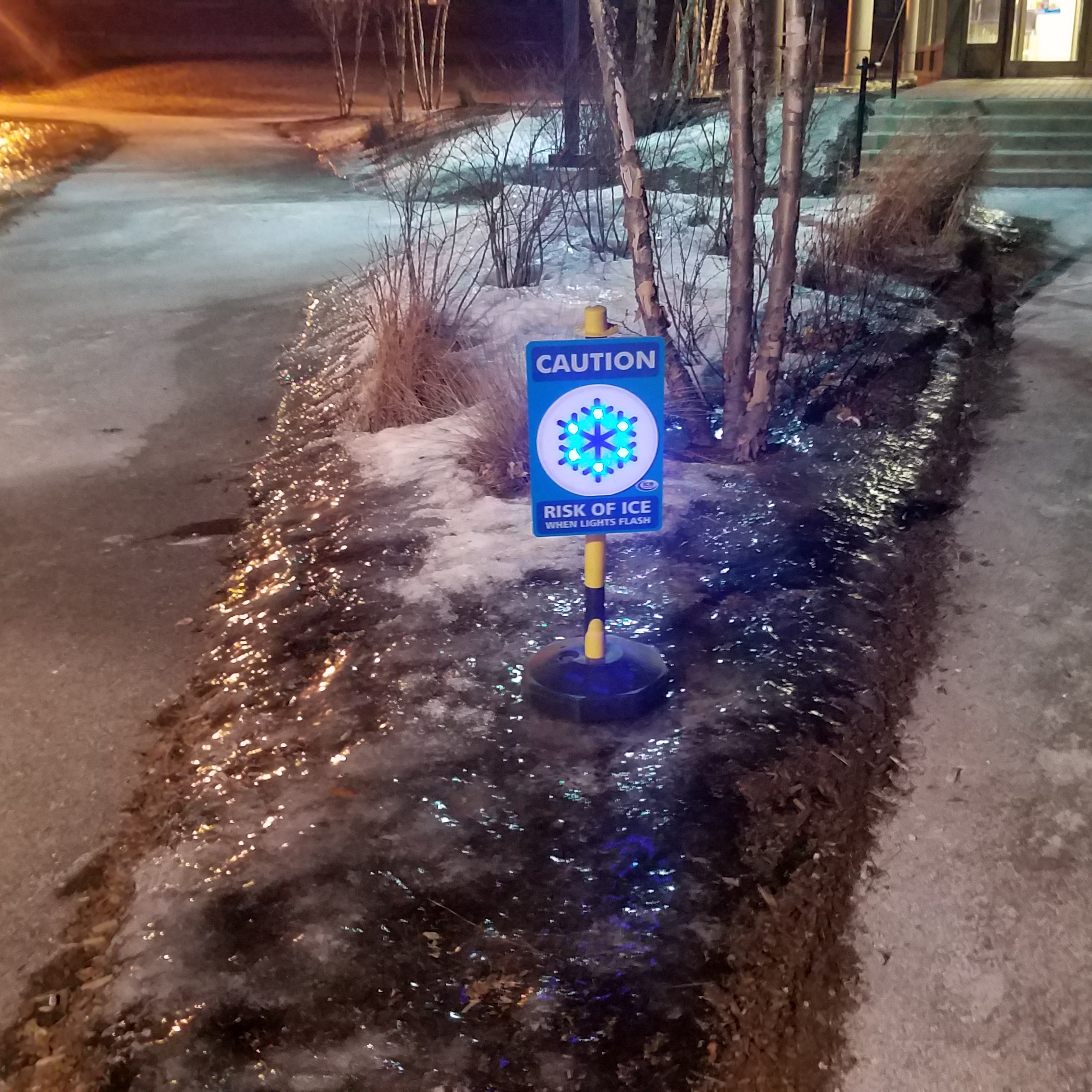
“A lot of what we’re seeing are accidents where people are falling between cars [on ice],” said Husson University Environmental Health and Safety Compliance Officer, Wynne Guglielmo.
“We [Husson Auxiliary Services] wanted to get something that did [look like] an alert and we figured blue was associated more it with police lights,” Guglielmo said.
This is why Husson decided to purchase the “AA” battery operated blue LED ice signs.
“The hopes are that people know this and actually take a bit more time when they’re walking around campus,” Guglielmo said.
There are two larger customized Husson ice signs mounted to the first stop sign at the exit and entrance of Broadway and Griffin road. There are several other slightly smaller ice signs which can be easily moved around campus. The bases of the movable bollard ice signs are filled with sand, which prevents them from wobbling in the wind.
“We’re [Husson Auxiliary Services] trying to get better about putting the word out. We know that students are inundated with emails. So many emails daily,” said Guglielmo.
Students can also help keep the campus safe for everyone. There are buckets of salt at the entrance and exit of every building on campus.
“If you noticed a very icy condition and you’re walking by it and happen to see the container of salt; throw some salt on it,” Guglielmo said.
Students, staff, and faculty can also report icy conditions to Guglielmo in Peabody Hall room 214 C next to the elevators. People can also report icy conditions to any custodian or member of maintenance.
“We have 208 acres here [on the Husson campus] and I know that they [custodial and maintenance] do a good job, but sometimes you miss things,” Guglielmo said.
The ice signs are all powered by “AA” batteries. The batteries are in the back of the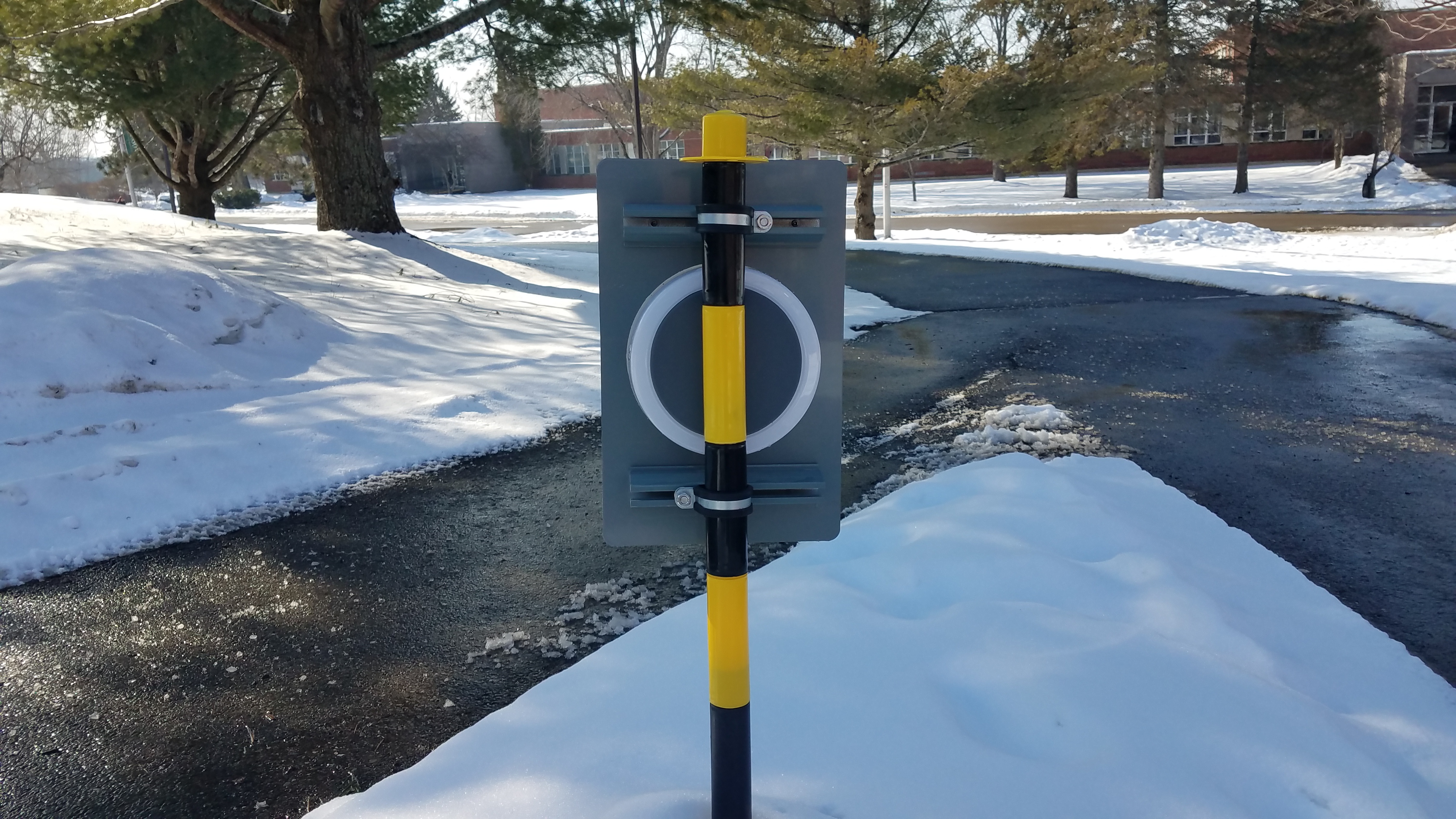 sign where the white circle is located. A rubber washer is between the batteries and circle casing. The batteries are expected to last a year to a year and a half before they need to be replaced. “It’s like an appliance at home where you have ‘AA’ batteries [in it],” Guglielmo said.
sign where the white circle is located. A rubber washer is between the batteries and circle casing. The batteries are expected to last a year to a year and a half before they need to be replaced. “It’s like an appliance at home where you have ‘AA’ batteries [in it],” Guglielmo said.
The only difference is the sign is turned on and off via two switches inside near the batteries.
The Husson Auxiliary Services are going to turn off the ice signs and store them over summer break. Guglielmo hopes to bring them back out again come Thanksgiving. As for the larger mounted signs, it has yet been decided if they will stay up year-round or going into storage with the movable signs.
The way Husson University found out about these ice signs were from a representative of their workman’s compensation insurance provider.
Husson has a safety committee, which meets monthly. The committee is made up of numerous managers from numerous different departments. A representative from their workman’s comp. insurance provider is also apart of the committee.
After looking at their accident reports over the past couple of years, the representative from the workman’s compensation insurance company asked the committee if they had ever heard of this signs that tell people when there are icy conditions. No one on the committee had heard of them before.
After hearing about them, Guglielmo’s intern did some research and found ice signs from a company in Brooklyn, New York.
“We wanted to do something that would catch someone’s eye,” Guglielmo said. The signs from Brooklyn did not use batteries. They changed color from white to blue 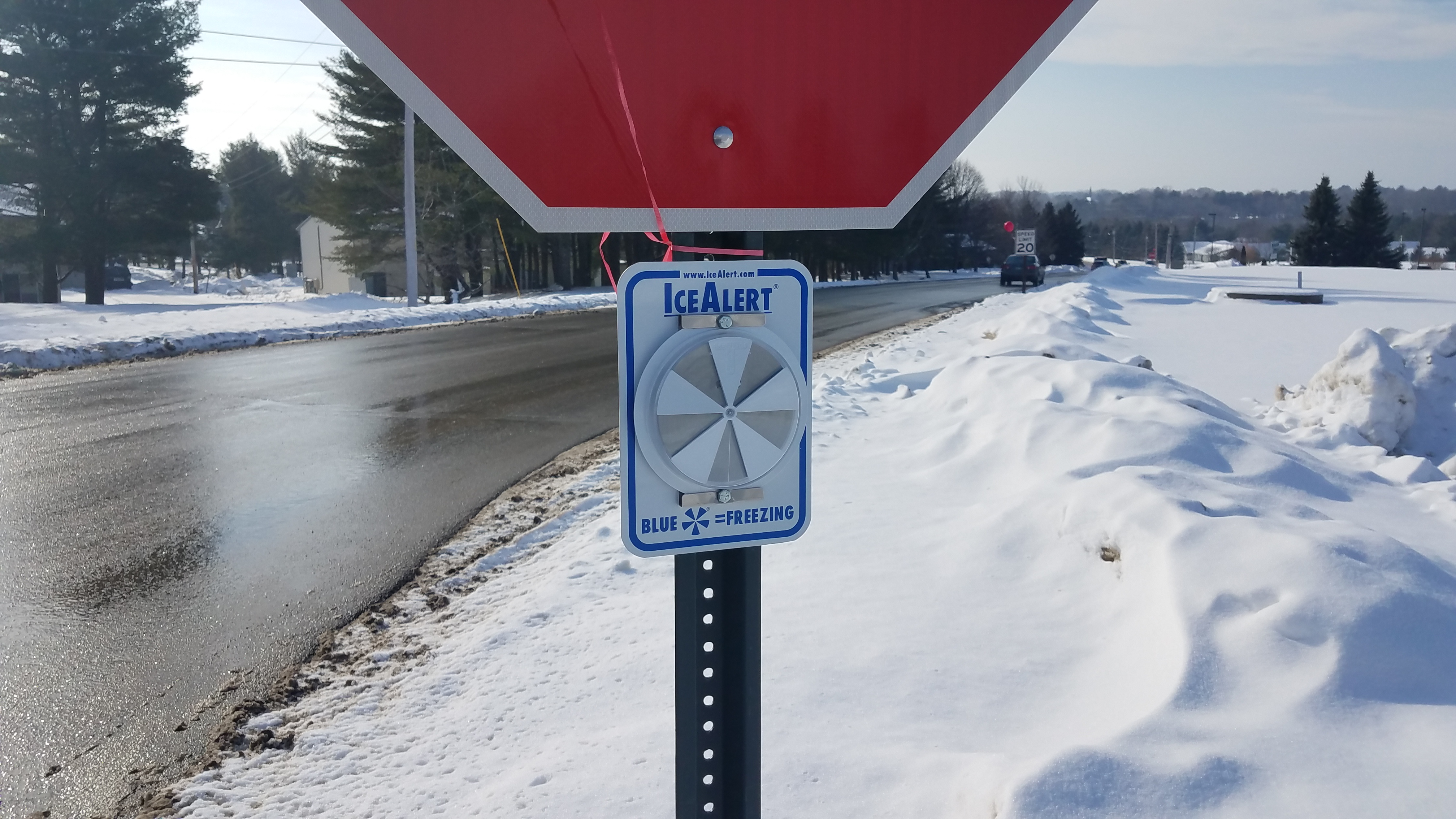 when the temperature was below 32 degrees. The signs operated similarly to a mood ring.
when the temperature was below 32 degrees. The signs operated similarly to a mood ring.
There was one problem with the signs. “They were so small,” Guglielmo said. “Unless you were really observant, you would miss them.”
This lead Guglielmo’s intern, an environmental science major named Raquel Gibbs, tacking down a bigger sign with flashing blue lights in England.
The product is called, Ice Guardian and it is produced by the British company named, Limelight Signs Ltd.
“Husson communicated with the British company via email. We did not have to make telephone calls across the Atlantic [Ocean],” Guglielmo said.
There was a time delay between the two organizations. This made communicating back and forth slightly more difficult.
“The U.K. [United Kingdom] is about five or six hours ahead of us,” Guglielmo said. “So if I sent an email at three in the afternoon, they had already left for the night, but the next day I would receive an email [from them].”
In order to pay for the signs United States dollars had to be converted in British Pounds, Sterling. With each of the five signs costing $360. The shipping was included in the total price.
The total cost was about $1,800 USD or about $1402.52 in British Pounds Sterling.
“They did a nice job. I’m very very impressed. Very impressed with the company. Very easy to work with,” Guglielmo said.
When the signs arrived at the campus of Husson University, they came in tight and carefully packed boxes.
They were all mostly assembled, the only thing to do was to put the movable signs in their bases and mount the mountable signs to the stop sign. Batteries were included for all the signs. 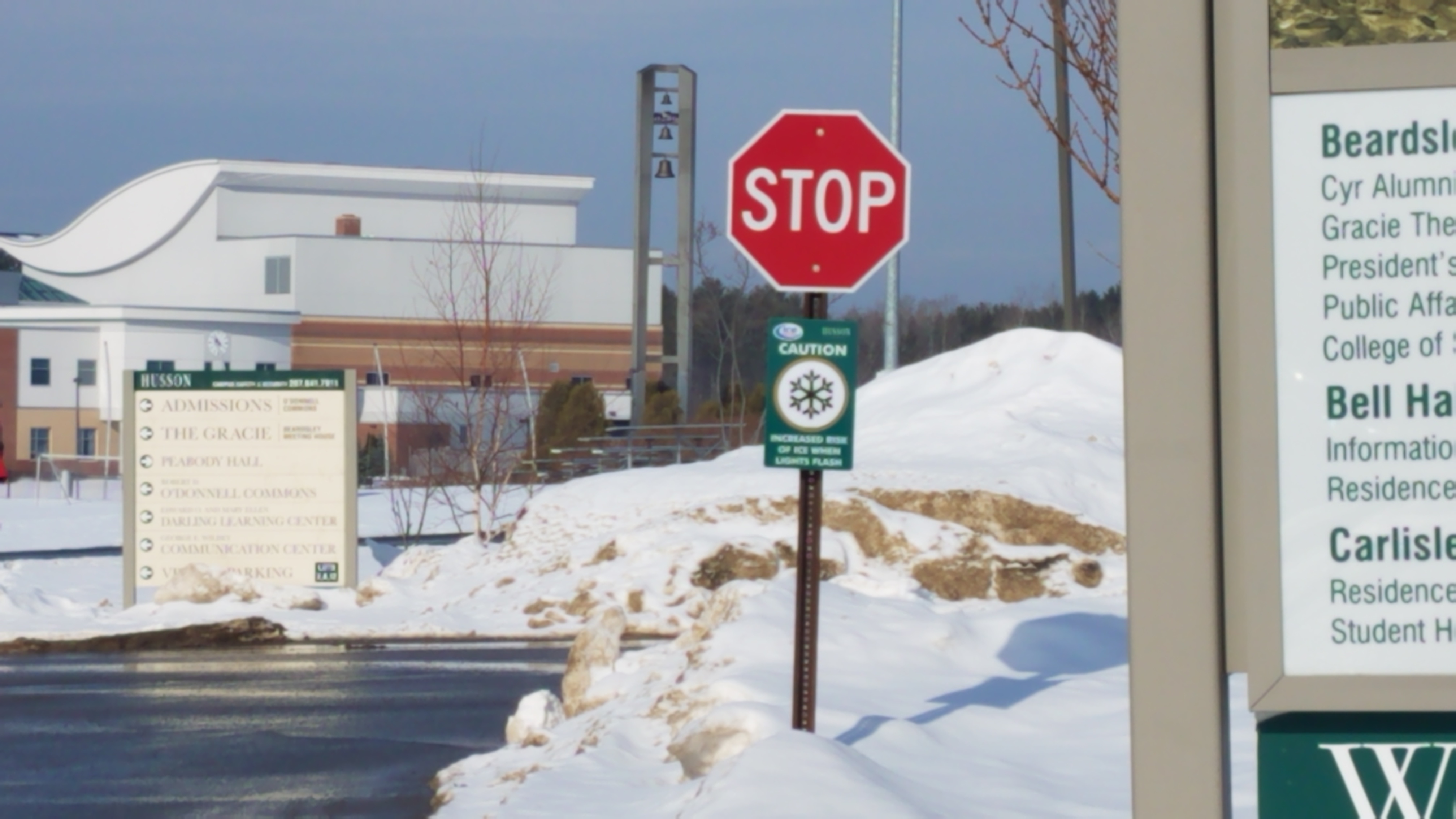
“In the scheme of things, I think that these [larger blue LED ice signs] captures your eye more,” Guglielmo said. “I think this will suit our campus more because it is more of a walking campus.
Over the next two years, Guglielmo wants to budget in five signs per year.
It is “ice” to know Husson University is taking care of its students, staff, and facility.

